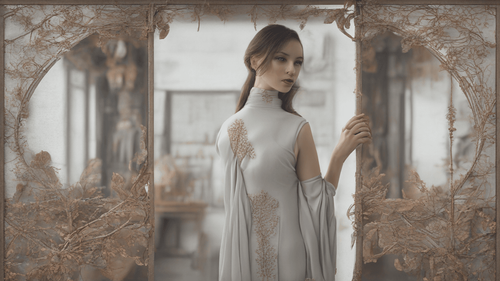
Introduction: Unleashing the Creative Power of AI
In the ever-evolving landscape of artificial intelligence, one remarkable innovation has taken the art and technology world by storm: AI's ability to create images from text. Imagine turning your vivid descriptions into stunning visual representations, transcending the boundaries of imagination. This transformative technology, known as text-to-image generation, harnesses the power of AI to craft captivating visuals that bring words to life. In this comprehensive guide, we'll delve into the fascinating realm of AI-created images, exploring their creation, applications, benefits, and the underlying technology that makes it all possible.
AI Create Image from Text: The Marvelous Process Unveiled
At its core, AI image generation from text is a process where artificial intelligence systems interpret textual descriptions and translate them into intricate visual compositions. This technology utilizes a combination of natural language processing (NLP) and computer vision algorithms to analyze the semantics of the provided text and generate images that match the intended content. Through a blend of neural networks and deep learning architectures, AI models can decipher context, emotions, and intricate details to produce images that align seamlessly with the textual input.
The Intricacies of Text-to-Image Generation: How Does It Work?
Text-to-image generation involves a multi-step process that showcases the seamless collaboration between language understanding and visual interpretation:
-
Text Parsing and Encoding: The input text is parsed and encoded into a format that AI models can comprehend. This encoding preserves the contextual information and nuances of the text.
-
Semantic Mapping: AI models create a semantic map of the encoded text, identifying key elements, objects, attributes, and emotions embedded within the description.
-
Visual Synthesis: Leveraging this semantic map, the AI model synthesizes visual features and components to craft an image that accurately represents the textual content.
-
Refinement and Enhancement: The generated image undergoes refinement processes to enhance its quality, coherence, and alignment with the original description.
The convergence of linguistics and visual processing within AI algorithms enables the creation of remarkably detailed and contextually relevant images from mere text.
Applications: From Concept to Canvas - Where AI-Generated Images Shine
AI-generated images hold boundless potential across various domains, catalyzing innovation and creative expression:
- Concept Visualization: Transform abstract ideas and concepts into tangible visual representations, aiding brainstorming sessions, design processes, and storytelling.
- E-Commerce and Advertising: Generate lifelike product images from textual descriptions, enabling efficient online merchandising and advertising campaigns.
- Gaming and Entertainment: Populate virtual worlds with AI-created characters, landscapes, and environments, enhancing immersive gaming experiences.
- Architectural Visualization: Translate architectural blueprints and descriptions into photorealistic visualizations, offering clients a preview of the final design.
- Art and Creativity: Collaborate with AI to bring artistic visions to life, pushing the boundaries of imagination and creating unique visual masterpieces.
The versatility of AI-created images extends across industries, revolutionizing the way we perceive, communicate, and interact with visual content.
Advantages of AI-Generated Images: Elevating Creativity and Efficiency
Embracing AI to generate images from text unlocks a myriad of benefits that redefine creative processes and streamline workflows:
- Unlimited Creativity: AI transcends conventional limitations, conjuring images that encompass diverse artistic styles, genres, and aesthetics.
- Time and Cost Efficiency: Rapid image generation accelerates design cycles and reduces production costs, enabling faster project turnaround.
- Enhanced Collaboration: AI-created images serve as visual reference points, fostering clearer communication and collaboration among teams.
- Immersive Storytelling: Enrich narratives by supplementing textual descriptions with captivating visuals that engage and captivate audiences.
- Personalization: Tailor visuals to specific preferences, demographics, and cultural nuances, resonating more deeply with target audiences.
The AI Behind the Art: Deep Dive into Neural Networks and Models
At the heart of AI image generation lies a constellation of advanced neural networks and models:
- Generative Adversarial Networks (GANs): GANs consist of a generator and a discriminator that work in tandem. The generator creates images, while the discriminator evaluates their authenticity. This interplay refines image quality over time.
- Variational Autoencoders (VAEs): VAEs encode input text into a latent space and decode it back into an image. This architecture promotes diverse and controlled image generation.
- Transformers: Transformers excel in understanding context and relationships within text, making them adept at creating coherent and contextually accurate visuals.
FAQs: Demystifying AI Image Generation
How Accurate Are AI-Generated Images?
AI-generated images strive for accuracy, leveraging vast datasets and complex algorithms. While not always perfect, they consistently produce high-quality visuals that align with the given text.
Can AI Capture Abstract Concepts?
Yes, AI can translate abstract concepts into visual representations by analyzing associated keywords, emotional tones, and contextual cues present in the text.
Are AI-Generated Images Original Works?
AI images are original in the sense that they are autonomously created by AI models. However, they may draw inspiration from existing visual patterns and styles.
Is Human Oversight Required?
Human oversight is often involved to curate and fine-tune AI-generated images, ensuring they meet specific artistic or design requirements.
How Does AI Handle Ambiguity?
AI interprets ambiguity by analyzing the broader context and incorporating potential interpretations, resulting in images that capture multiple facets of the text.
Are There Copyright Concerns?
Copyright considerations may arise if AI-generated images resemble existing copyrighted works. Legal experts recommend evaluating each case individually.
Conclusion: A New Era of Artistic Expression
In the realm of AI, the marriage of language and imagery has birthed a captivating evolution: the ability to create images from text. This technology transcends boundaries, empowering creativity, efficiency, and collaboration in unprecedented ways. As AI continues to evolve, so too will its capacity to transform textual descriptions into breathtaking visual marvels, bridging the gap between imagination and reality. Embrace the future, where AI's artistic prowess paints a new canvas of possibilities, one pixel at a time.